Entering new markets is always an adventure, and adventures always involve some risk. Moving beyond your current market is challenging, but a well-informed go-to-market strategy ensures you’ll thrive in your new market environment.
This guide aims to help businesses build a data-driven go-to-market strategy. First, we’ll explore exactly what a go-to-market strategy is and why it’s important. Then, we’ll offer a step-by-step process for developing your own.
What Is a Go-to-Market Strategy?
A go-to-market strategy–also called a GTM strategy–is a blueprint outlining the actions you’ll need to take to get your product to your target audience and ensure it delivers on its unique value proposition.
You’ll consider a variety of key market characteristics when building a go-to-market strategy. These characteristics might include:
- The market’s size, competition levels, and major players
- The audience’s demographics and pain points
- The product-market fit
- Local and international market characteristics
- Common marketing approaches, sales funnels, and pricing strategies
Research is an important part of building your go-to-market strategy. You’ll need to gather data on each of these aspects of your market to inform your decisions.
To gather data, you can look at free industry research (here’s an article listing a bunch of free resources), hire a market research firm, or conduct research with market customers on your own with focus groups or surveys. You can try a market research solution like Semrush .Trends to gain insights into your target market and its most important emerging trends.
What’s the Difference Between a GTM Strategy and a Product Launch Strategy?
The difference between a go-to-market strategy and a product launch strategy is a matter of scale and focus.
A go-to-market strategy is a broad outline, describing how your business will engage with a market and reach its target customers. It encompasses market analysis, pricing, distribution channels, promotion, and more. It addresses the overall approach to introducing a product or service.
On the other hand, a product launch strategy is one component of the go-to-market strategy, focusing specifically on introducing a new product. It involves creating awareness, generating excitement, and ensuring a smooth introduction. These goals are accomplished through activities like promotional materials, launch events, and messaging coordination.
While the go-to-market strategy is comprehensive, the product launch strategy is a focused plan for the successful introduction of a specific product.
What Are the Benefits of Go-to-Market Strategies?
Developing a well-crafted GTM strategy can significantly improve the success and sustainability of your business. Without a clear strategy, you’re likely to waste resources, miss opportunities, and become vulnerable to competitors.
On the other hand, a strong go-to-market strategy ensures you spend wisely, seize opportunities, and stay ahead of competitors. Here are some of the key benefits of a strong go-to-market strategy:
- Set out with clear objectives: Your go-to-market strategy provides a roadmap for everyone within your organization. It outlines steps and defines milestones. With this clarity, you can align the efforts across the business to achieve the same goals.
- Allocate resources wisely: Identifying target markets, segmenting audiences, and pinpointing the best distribution channels, allows you to invest your resources for the highest impact.
- Gain a competitive advantage: Defining your unique value proposition, differentiating your business from competitors, and understanding competitors’ strengths and weaknesses lets you gain an edge and make better moves.
- Drive more sales: Pinpointing the most effective sales and distribution channels and creating offers for specific target audiences allows you to generate more leads and convert more customers.
- Adapt to market changes: A dynamic go-to-market strategy takes into account the ever-evolving nature of the market and consumer preferences, so you’re business is ready to pivot when necessary.
Overall, a good go-to-market strategy serves as a guiding framework that not only facilitates successful product launches but also lays the foundation for long-term business growth, sustainability, and competitive advantage in the marketplace.
Your Go-to-Market Strategy Template
Whether you’re launching a new business, or taking an existing business into a new market, your go-to-market strategy will provide you with a clear direction and help mitigate risk. The actions below will provide you with the foundation you need for success.
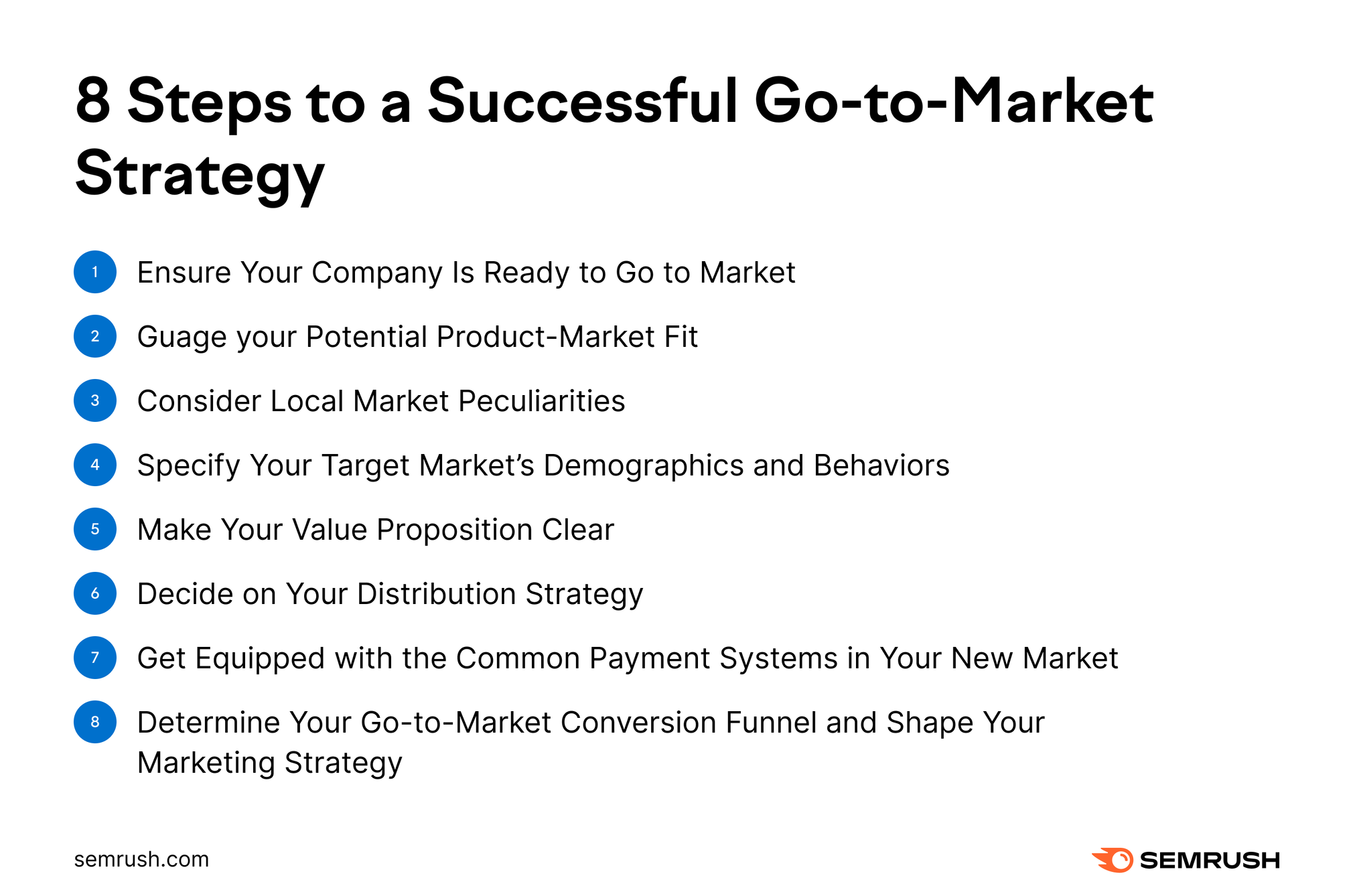
1. Make Sure Your Company Is Ready to Enter a New Market
Entering a new market is a complex process that requires alignment across your entire organization. Before making the leap, be sure you’re ready.
Here are some questions to address:
- What do we want to achieve with this expansion? Providing a clear answer to this question makes sure everyone is working toward the same goals and that they’re measurable.
- Do we have the infrastructure and capital we need? Make sure you can afford to expand and have the internal resources to be successful. Plan for unexpected costs and challenges.
- Do we have the human resources? Expanding into new markets takes a lot of effort. Think carefully about the human resources available within your business and any existing talent gaps.
- Is now the best time to enter the market? Determine the best time to act. This involves carefully analyzing the target market, political climate, economic situation, and more.
Answer these questions honestly and gauge your readiness according to the answers. Ultimately, entering a market fully prepared lowers risks and increases your competitiveness.
2. Guage your Potential Product-Market Fit
Product-market fit is the degree to which your product or service effectively satisfies a market’s demand. In order to determine whether you’ve got a good product-market fit, you’ll need to do some market research.
Begin with some simple questions to gauge product-market fit:
- What problem or pain point does my product or service solve for this particular market?
- Will customers in this target market be willing to pay for the product or service my business offers?
- Who are the market leaders and are they offering products that are similar to mine?
- What key features or aspects resonate most with customers within the target market?
- What kind of potential does my product or service have for long-term growth and sustainability in the market?
If the answers you come up with to these questions aren’t clear or don’t suggest a strong fit for your product or service, you may want to look to enter a different market.
Market Demand and Growth
Market demand and growth potential are other metrics you can use to gauge product-market fit. One way to measure demand and growth potential is by looking at the Total Addressable Market (TAM) and the Serviceable Available Market (SAM). These metrics reveal how much demand there is for a particular product or service on the market.
For example, here’s a look at the market for Ray-Ban sunglasses in Brazil using Semrush’s Market Explorer. In Brazil, traffic in the sunglasses market is increasing, and the TAM and SAM reflect a broad market with plenty of room for growth.
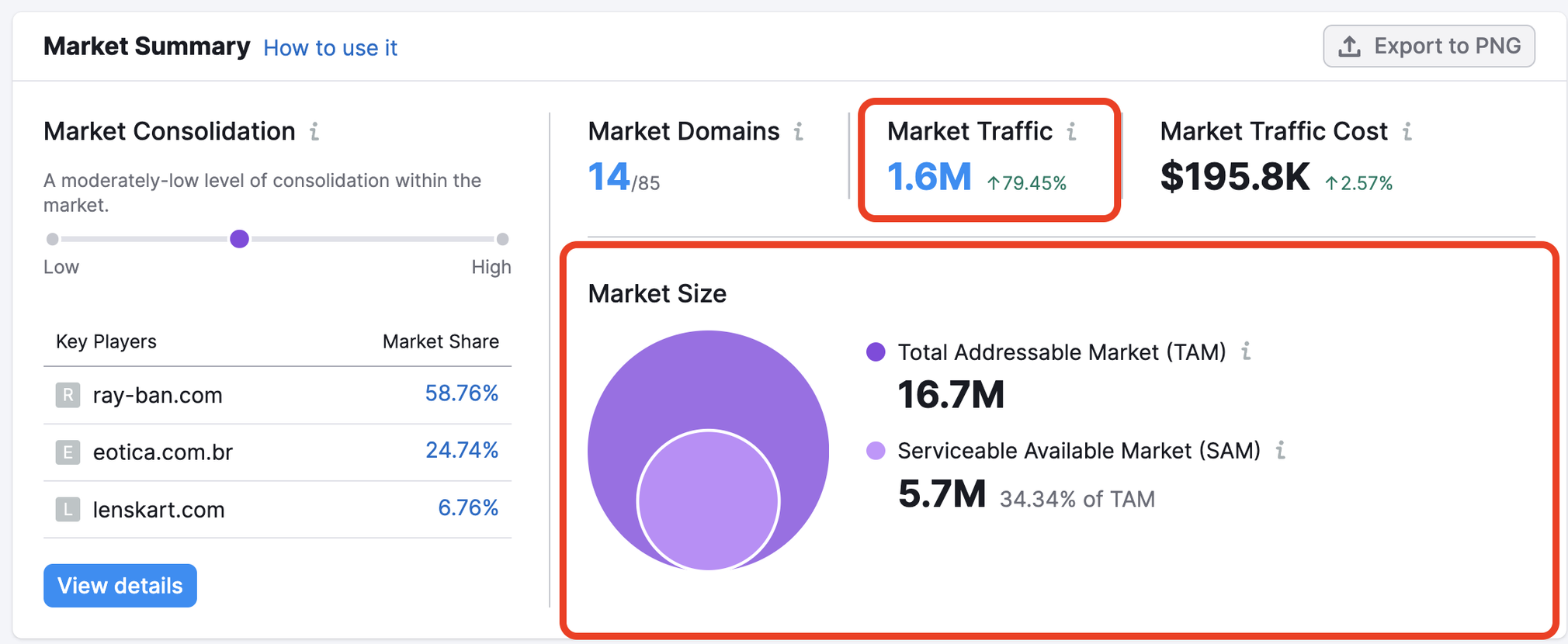
Compare Brazil’s market to the market for sunglasses in the United Kingdom. While there’s certainly a market here for sunglasses, it’s not as robust as the Brazilian market.
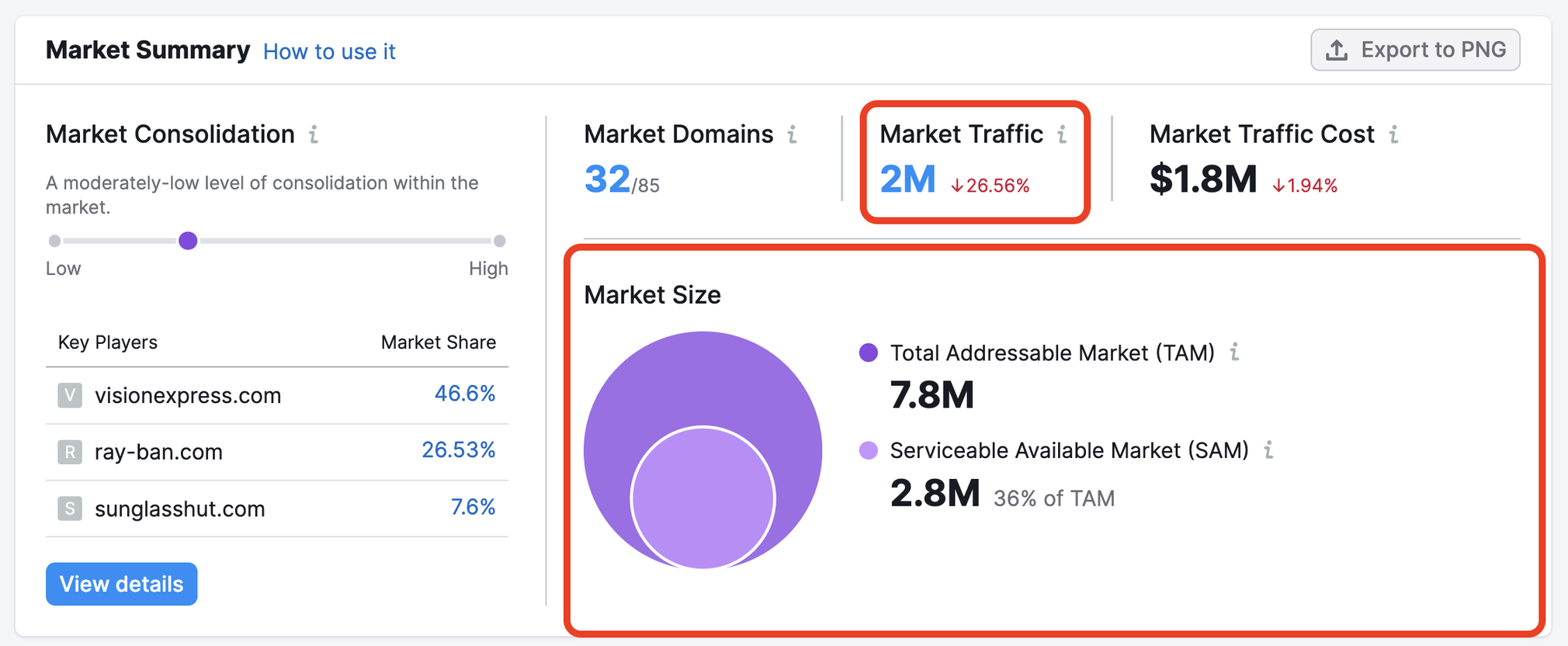
By answering key questions and evaluating market demand through metrics like market traffic alongside TAM and SAM, you can gain valuable insights into the potential for growth and success in a particular market. Ultimately, you want to ensure that entering the particular market is worth the costs included.
Market Leaders and Their Offerings
Considering the most successful companies in your market and understanding what they offer is another technique for evaluating whether your product is a good fit for the market. You might consider the fastest-growing companies or the leaders within your particular market niche.
Here’s a look at the Sunglasses market using Market Explorer’s Growth Quadrant. Here, we can see the top domains based on their traffic growth.
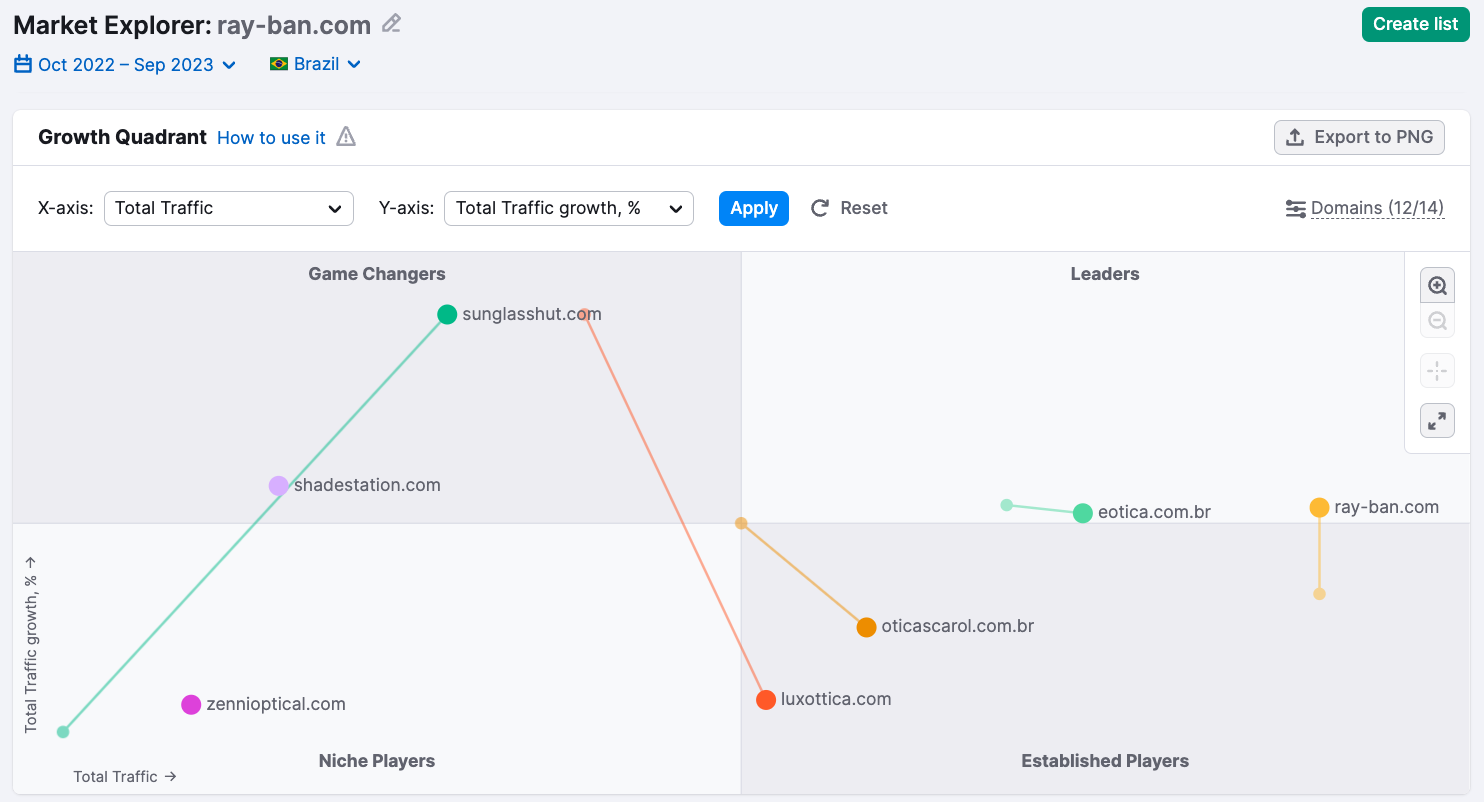
After identifying particular players that have seen the most growth this past year, we can dig into their offerings using the Traffic Analytics Top Pages report. Notice sunglasshut.com in the Game Changers quadrant above. Here’s a look at the domain’s top products.
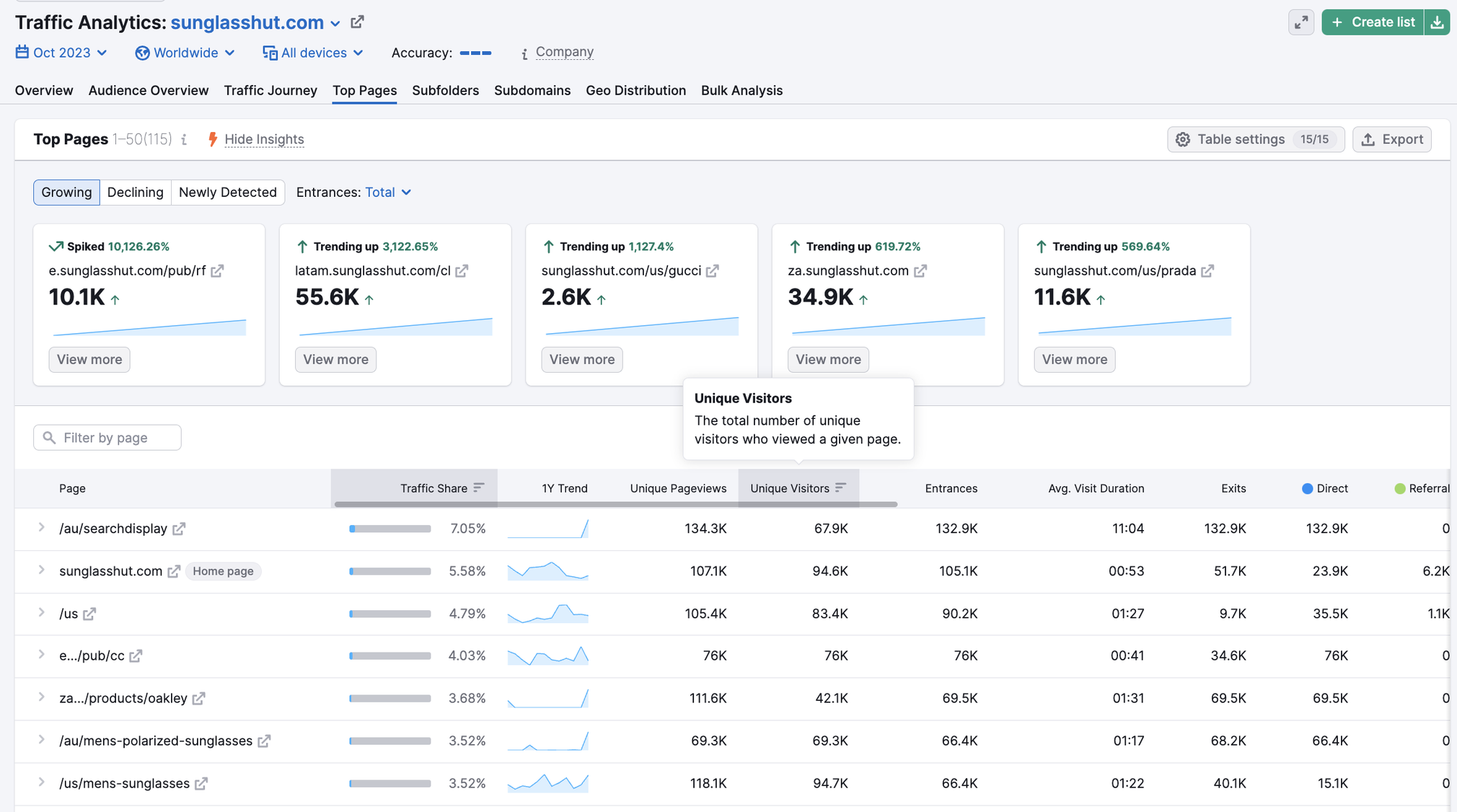
Studying their approach to customer engagement, product design, pricing strategies, and overall market positioning can help you identify gaps and opportunities within the market. Furthermore, evaluating the strengths and weaknesses of the offerings from these industry giants can help you pinpoint areas where your product can excel and provide a unique value proposition.
3. Consider Local Market Peculiarities
Once you have a particular market in mind, consider the market’s specific characteristics. All markets, even those in the same geographical regions, are different. Get to know your potential market as well as possible to avoid costly surprises down the road.
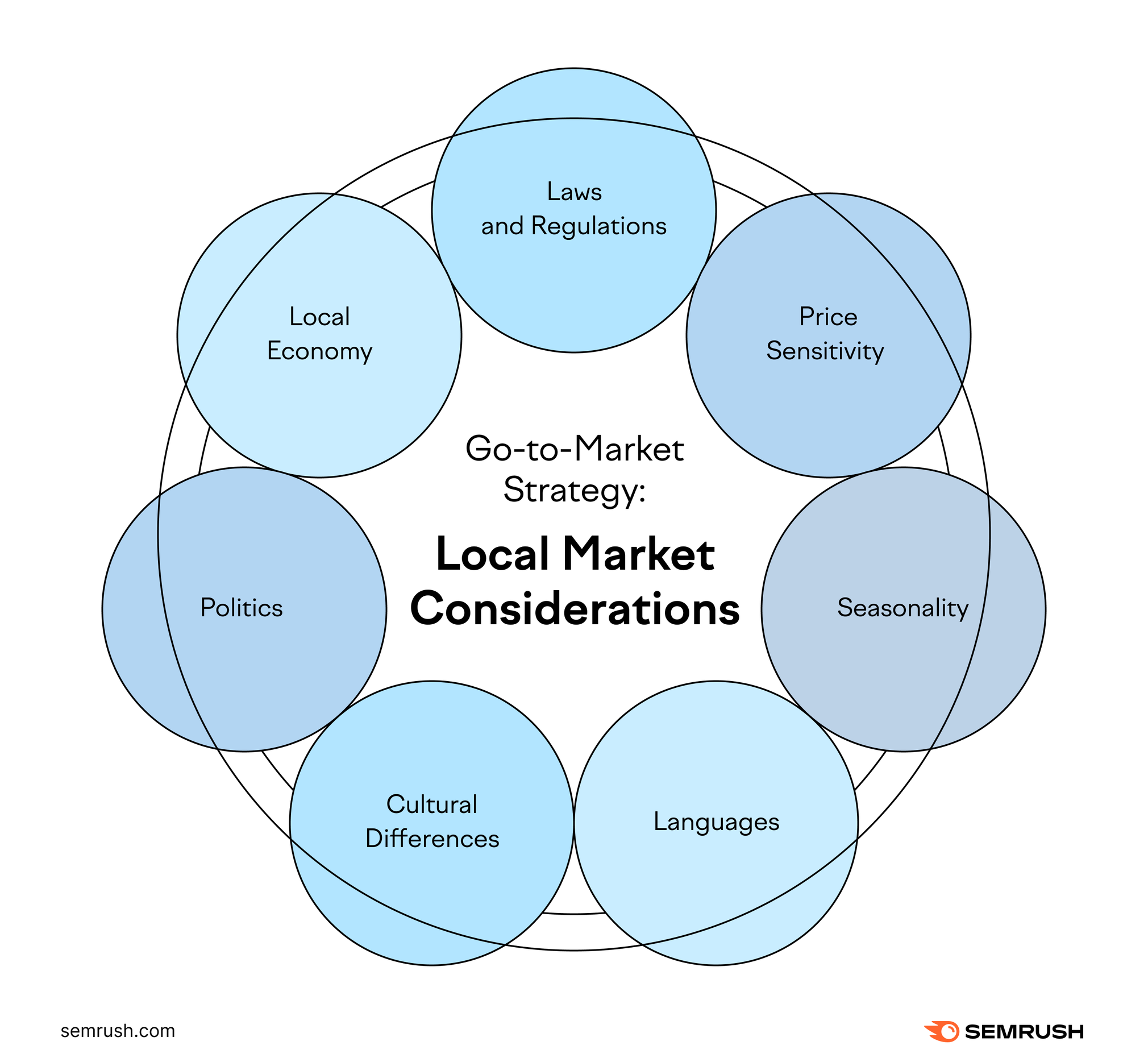
Examine the Economic Situation
Assess the economy surrounding your potential market. Is it growing or shrinking? Are people employed or unemployed? Are the market’s customers strapped for cash?
Skipping this step could leave you unable to get your footing in your new market. Best Buy confronted this problem in the UK in 2010. Ignoring the already unfolding global recession, they decided to try to set up shop in the UK with an eye toward strategic acquisitions. The state of the economy globally, and specifically in the UK, however, led to a serious failure.
Analyze local laws and regulations
Local laws and regulations can put a damper on business if you’re not careful. Laws can vary by country, state, or even city by city, so be sure to dig deep to avoid potential hangups.
Uber’s challenges in Seoul, South Korea, offer a good example of the potential problem businesses can face with local laws and regulations. The bearish taxi industry in the country has led to tight governmental regulations, which has created problems for the ride-sharing service’s expansion in the country.
Understand Local Politics
To gain a handle on the business climate of a location, a thorough understanding of local politics is necessary. Some markets may not prove as suitable because of an investment-unfriendly political climate or overall political instability.
In the business world, this is reflected in the PEST(ELI) test the global business community often refers to when considering market expansion.
Consider Language Barriers
Entering new markets requires communicating with potential customers who may not have heard about your business. In many cases, this could mean translating lots of content into different languages, which can be an incredibly costly endeavor.
Failing to localize can lead to big issues for your business. Take the WhatsApp expansion in Germany for example. After failing to translate their terms of use into German, the Federation of German Consumer Organizations filed a lawsuit against the company charging that the technical language was “largely incomprehensible” to German users.
A small oversight cost the company more than a quarter of a million euros. A business with less cash at the ready may not have weathered this challenge successfully.
Understand cultural differences
To successfully engage with customers in any market, you need to understand their cultural values, customs, and norms. Cultural understanding allows you to not only communicate effectively but also build trust and avoid misunderstandings that could severely damage your brand in the eyes of consumers.
As an example of serious cultural oversight, consider DoorMint’s failed expansion into India. The on-demand laundry service failed to recognize the significance of traditional launderers, or dhobi, which have long satisfied this need in the country. DoorMint was unable to compete with cultural tradition.
Study Price Sensitivity
Along with studying the economy, look at factors such as the average resident’s average amount of disposable income and the amount of money they’re willing to pay for a product. If the margin is too low, people may not be able to afford your products, or they may go with a cheaper option.
Take, for example, Blockbuster. The now-defunct movie rental business continued to raise prices, even as streaming services were offering more content at a cheaper cost. Ultimately, their inability to accommodate price sensitivity in their market led to their demise.
Be Alert for Seasonality
Last but not least, geographic realities such as reversed seasons between the Northern and Southern Hemispheres may have a huge impact on consumer demand.
This is a common issue in industries like travel and tourism. If the seasonal variations have a large impact on your industry, you’ll want to plan accordingly so you can weather slow seasons and cash in on the peak seasons.
4. Specify Your Target Market’s Demographics and Behaviors
Understanding your target customers is a fundamental part of your go-to-market strategy. Deep knowledge of your audience allows you to effectively position your product or service, clearly communicate its value to the audience, and share your messages in places where the audience spends time.
You’ll want to gather as much demographic data as possible about your audience, but here are some common characteristics you might consider:
- Age: Consider the age group that is most likely to be interested in your product. Is it tailored to younger consumers, or does it cater to a more mature audience? Understanding this aspect helps you craft content and design that resonates with your target age group.
- Sex: Some products and services may appeal more to men than women, or vice versa. Knowing this can influence your marketing approach and the language you use in your messaging.
- Household size/family status: Customize product sizes, bundled offerings, and pricing packages that align with their consumption requirements. Insights into family dynamics help in addressing unique needs and challenges through your product or service offerings.
- Income level: Understand the income bracket your product’s price point aligns with. This insight guides your pricing strategy and the affordability of your offering for your target audience.
- Education level: Account for the education level of your target market to develop communication strategies that effectively convey the value of your product or service in ways the audience will respond to.
Here’s an example of the above metrics for the market for sunglasses in Brazil from Semrush’s One2Target tool.
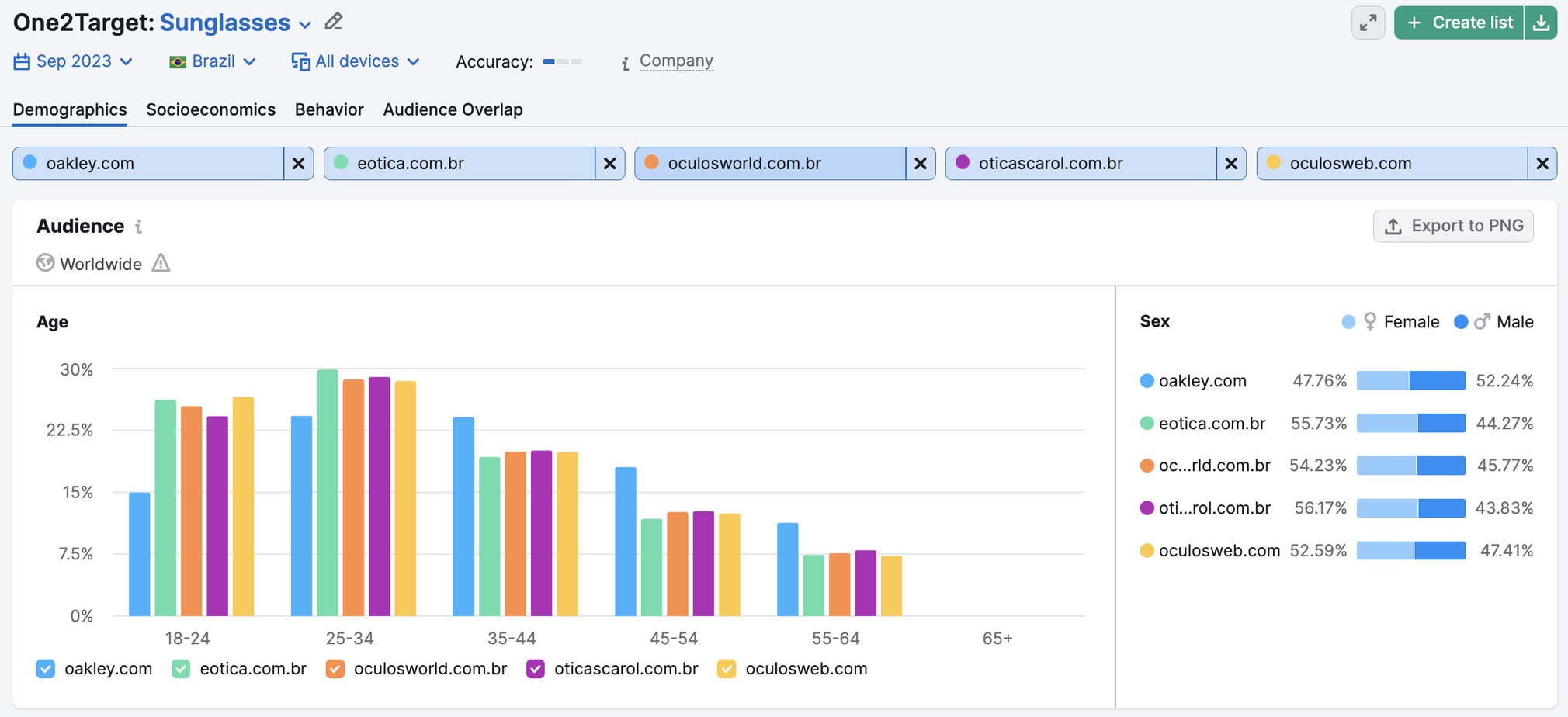

With this data, we understand the market is on the younger side, with the biggest segments in the 18-34 range. There’s an even split between men and women, and most have a low income and live in households with 3-4 people.
In addition to demographics, delving into the behaviors of your target market is equally important. Behavior includes everything from shopping habits to online activities and brand loyalty.
- Purchase Behavior: How does your target market typically make purchasing decisions? Do they prefer online shopping, in-store visits, or a blend of both? Understanding this can shape your sales channels.
- Brand Loyalty: Is your target market loyal to particular brands, or are they open to trying new ones? If brand loyalty is strong, breaking into the market may require different tactics than a more brand-agnostic group.
Here’s a look at domains also visited by individuals who went to oakley.com. Notice two of the five domains are surfing-related websites:

- Problems and Pain Points: What issues or pain points does your product or service address for your target market? Knowing this helps tailor your messaging to focus on solutions and benefits.
- Online Activity: In the digital age, an understanding of online behaviors is critical. Are your potential customers active on social media? Do they research products extensively online? This knowledge directs your digital marketing efforts and content creation.
Here’s a breakdown of social media usage among audience members in Brazil’s market for sunglasses.
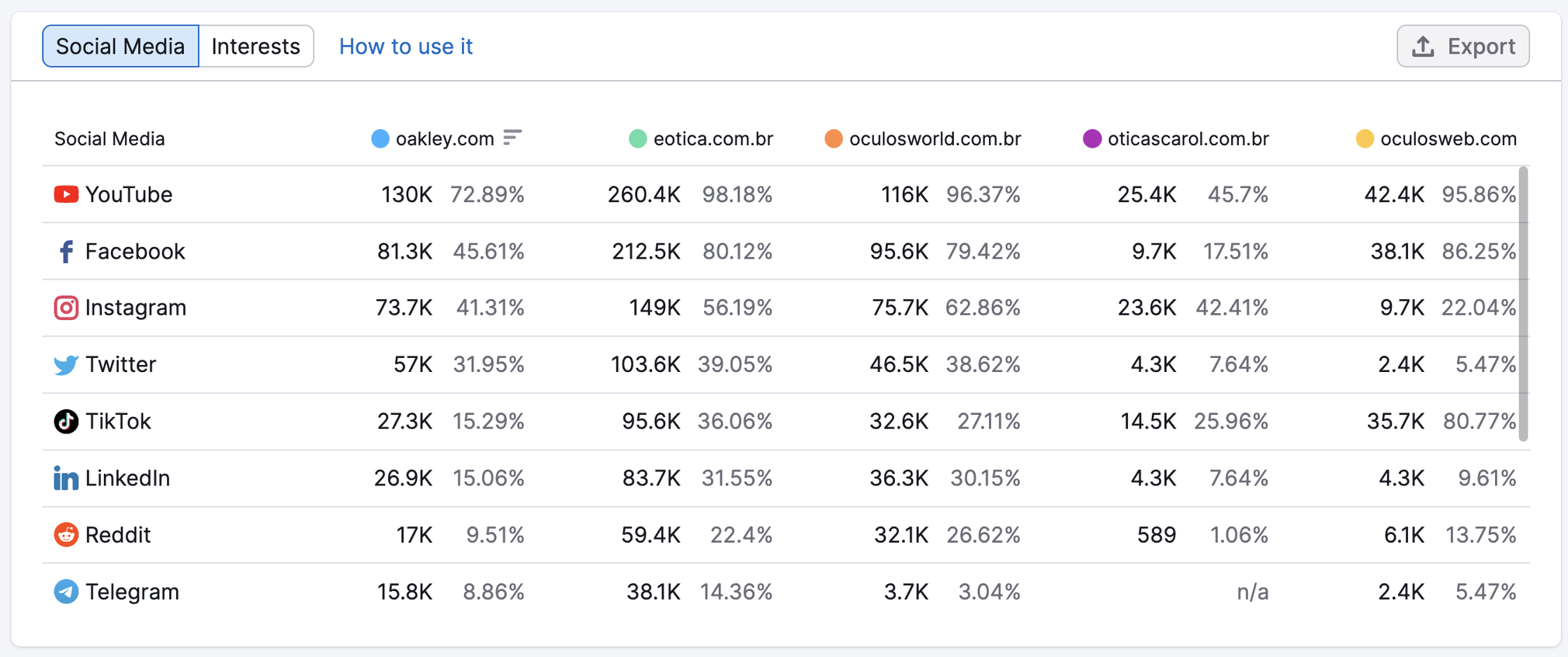
- Content Preferences: Does your audience prefer written content, video, podcasts, or visual graphics? Look at overall trends, like the rise of video content over the past few years. Also, consider generational differences within your audience. For example, while Gen X may engage with long-form content, Gen Z gravitates toward short video content.
By specifying your target market’s demographics and behaviors, you gain a more comprehensive view of who your ideal customers are and how to reach them effectively. This knowledge enables you to create a go-to-market strategy that is well-informed and highly targeted, setting the stage for successful product launches and marketing campaigns.
5. Make Your Value Proposition Clear
A value proposition is a concise statement that explains the unique value your product or service provides to your customers. It highlights the specific benefits or solutions that differentiate a business from its competitors.
To craft your value proposition, consider what benefits customers can expect and define your key differentiators.
Start by answering these three questions:
- How does your product or service solve/improve problems?
- What benefits can customers expect?
- Why should customers buy from you instead of your competitors? In other words, how are you better than your competitors?
Then, articulate a value proposition that will intersect all three.
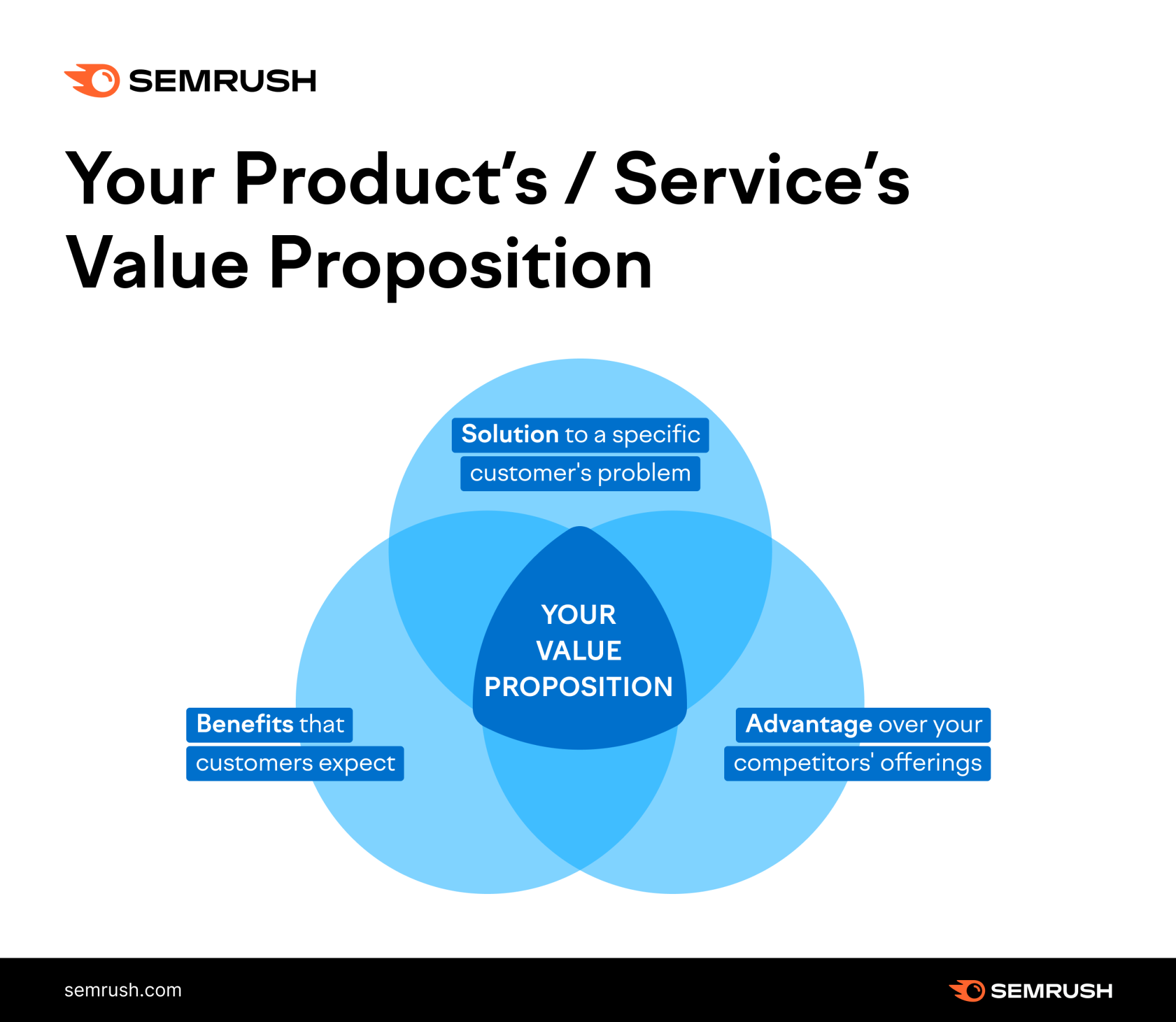
Be careful to research your specific market. What works in one region or niche may fail in another. Your offering may be too complex or irrelevant, the price may be too high, or you may face any number of other obstacles. Even successful brands find some markets where their products and services aren’t in high demand.
Coke, for example, attempted to market two-liter bottles in Spain. Despite the brand’s popularity, their venture failed because Spanish refrigerators typically couldn’t hold such big bottles. Instead of solving a problem here, Coke created one!
Define your value proposition properly. Supported by the specified customer persona and underserved needs, a good value proposition can help you achieve product-market fit in the target region.
6. Decide on Your Distribution Strategy
Once you’ve defined your product-market fit, analyzed your target audience, and made your value proposition clear, you’ll need to figure out how to distribute your product or services to customers.
Globalization has changed the way many companies approach distribution. Manufacturing processes can be spread across the world, and products can be delivered to the market on an as-requested basis. Likewise, for many companies that offer services, especially in the form of software, geographic borders often only matter in terms of legislation, talent hiring, and language barriers.
Despite the benefits of global distribution systems, it’s still important to think carefully about how you’ll bring your product or service to customers. It can help to think about distribution in three categories and consider the benefits and pitfalls of each.
Direct Distribution
Direct distribution is focused on distributing products or services through company-owned channels, more and more businesses are moving in this direction. Direct distribution permits companies to cut out the middleman and own every part of their operation, often resulting in higher customer satisfaction.
Some challenges with direct distribution include:
- High costs to establish systems
- Complexity with management and logistics
- Limited reach and market penetration
- Customer service challenges
- Dependency on internal expertise
Apple is a prime example of a business focused on direct distribution. They operate their own retail stores worldwide and also do business through the Apple Store online.
Indirect Distribution
Indirect distribution involves partnering with third parties to sell and fulfill your company’s products or services. Many big-name companies use this approach to leverage relationships through third-party partners.
Some challenges with indirect distribution include:
- Reduced control over the customer experience
- Limited access to direct customer insights
- Dependency on distributors’ performance
- Potential conflicts among distributors
- Margin erosion and pricing pressure
Nike is one company known for its success in indirect distribution channels. They sell products through a number of retail outlets and third-party distributors worldwide.
Hybrid Distribution
Hybrid distribution systems offer a blend of company-owned and third-party mechanisms, providing businesses with the flexibility to leverage the advantages of both direct and indirect distribution models. By combining these approaches, companies can achieve a broader market reach while maintaining a certain degree of control over the distribution process.
Challenges associated with hybrid distribution include:
- Balancing control and flexibility within the distribution network.
- Managing complexities with coordinating channels
- Ensuring consistent brand representation
- Navigating potential conflicts in strategies
- Optimizing operational costs and efficiency
Microsoft utilizes a combination of direct distribution through its online store and retail locations, as well as indirect distribution through partnerships with various third-party retailers and distributors worldwide.
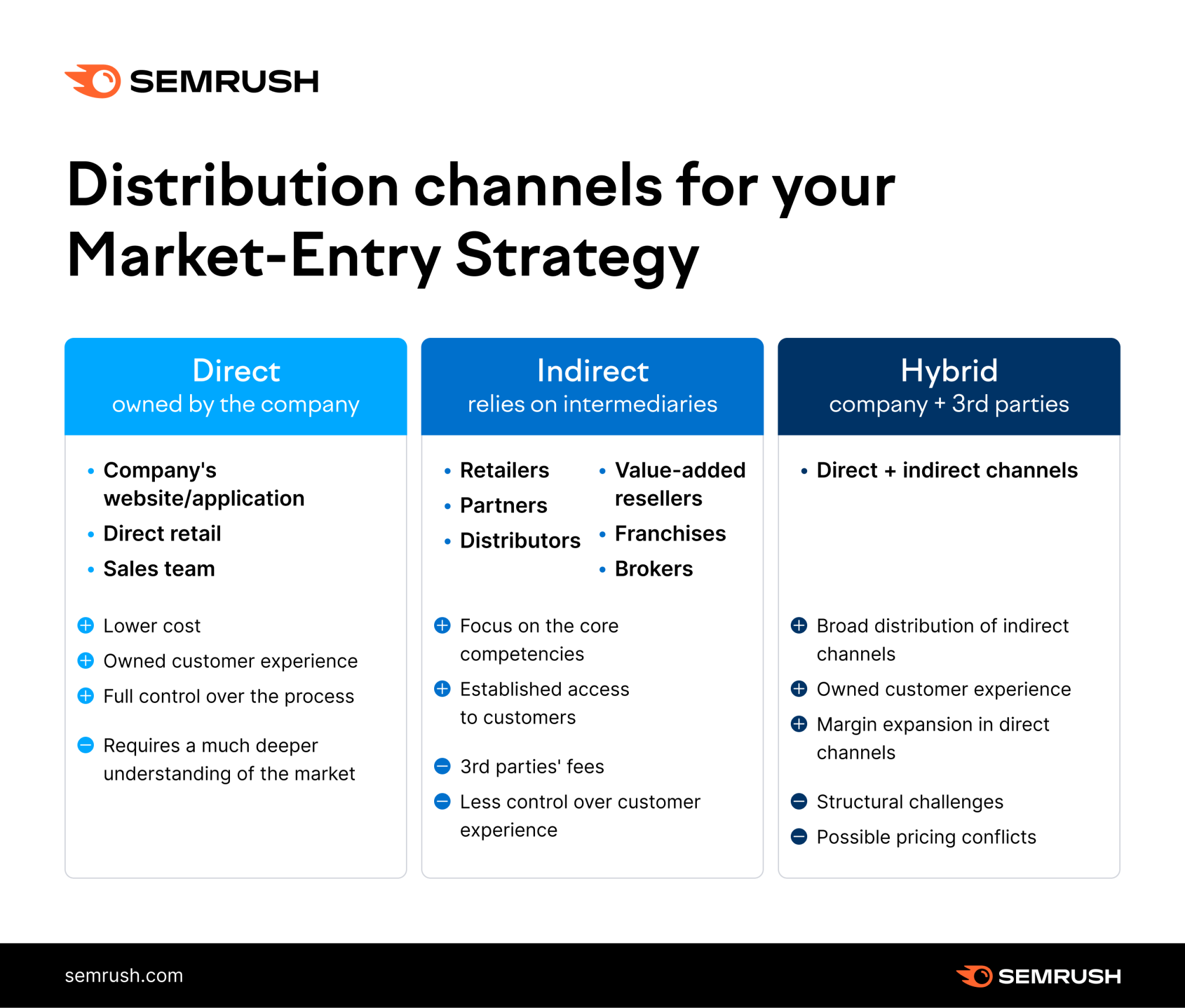
In an increasingly globalized marketplace, choosing the right distribution strategy is pivotal. Understanding the nuances and challenges within each model is crucial for companies to effectively reach their target markets while ensuring customer satisfaction and brand consistency.
7. Get Equipped with the Common Payment Systems in Your New Market
Making sure consumers have the right options for payment can be the difference between closing and losing the sale. Before going to market, make sure you’re equipped with everything you need to make sure customers can seamlessly purchase what they’re looking for.
Let’s consider the most common ecommerce and CNP (card-not-present transaction) payment methods globally and regionally to compare.
Global Ecommerce Payment Methods
Globally, 44.5% of people prefer paying for items with a digital or mobile wallet, while debit cards are the most common CNP method at 25.7%. These numbers are projected to grow to 51.7% and 33.4% respectively by 2024.
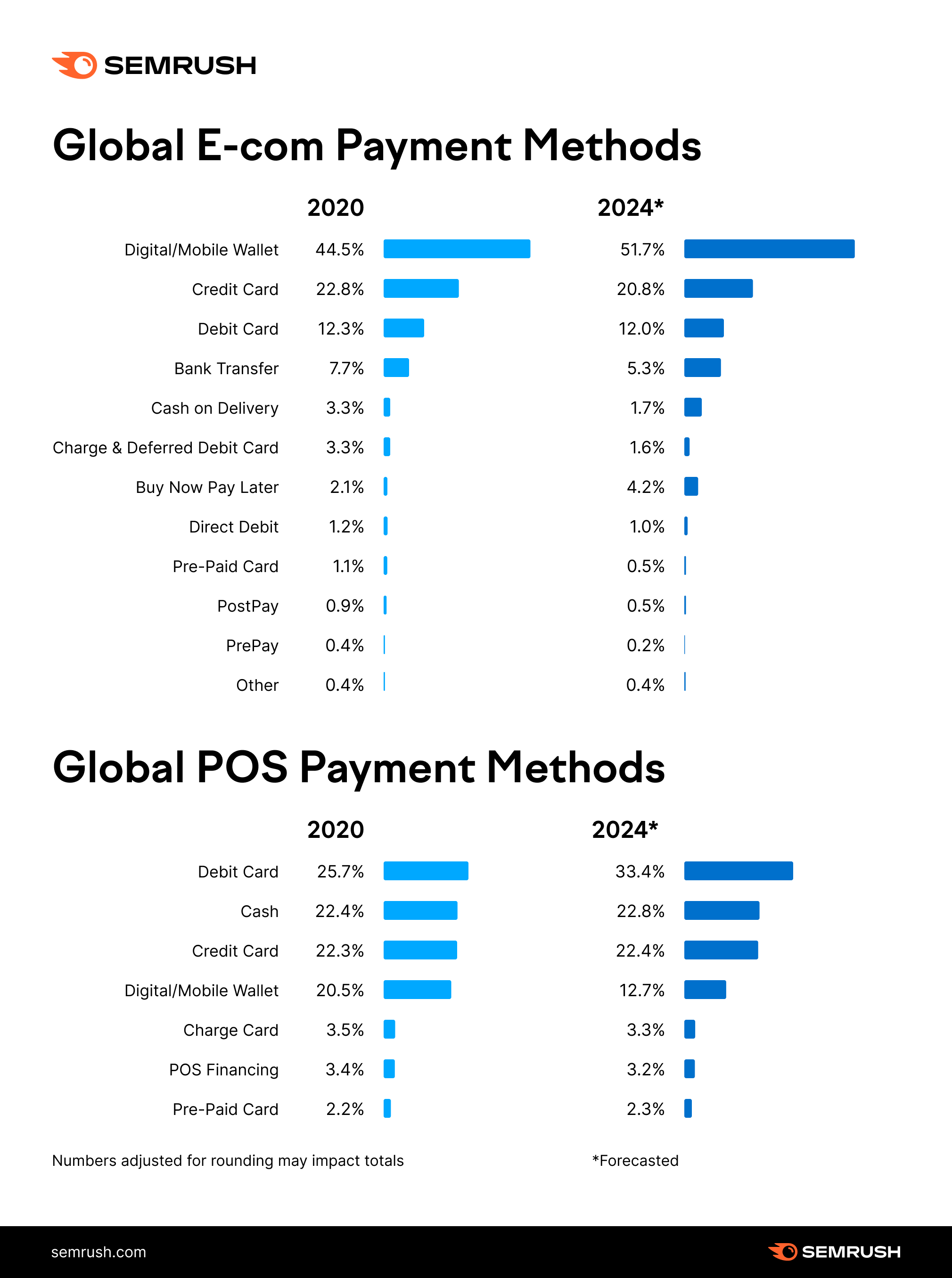
Europe Ecommerce Payment Methods
In Europe, bank transfers account for 13% of payments, which is much higher than the global average. While this number is comparatively high, it’s projected to dwindle to 11% by 2024. Even so, at 11% it’s an important method to consider when thinking about payments in European markets.
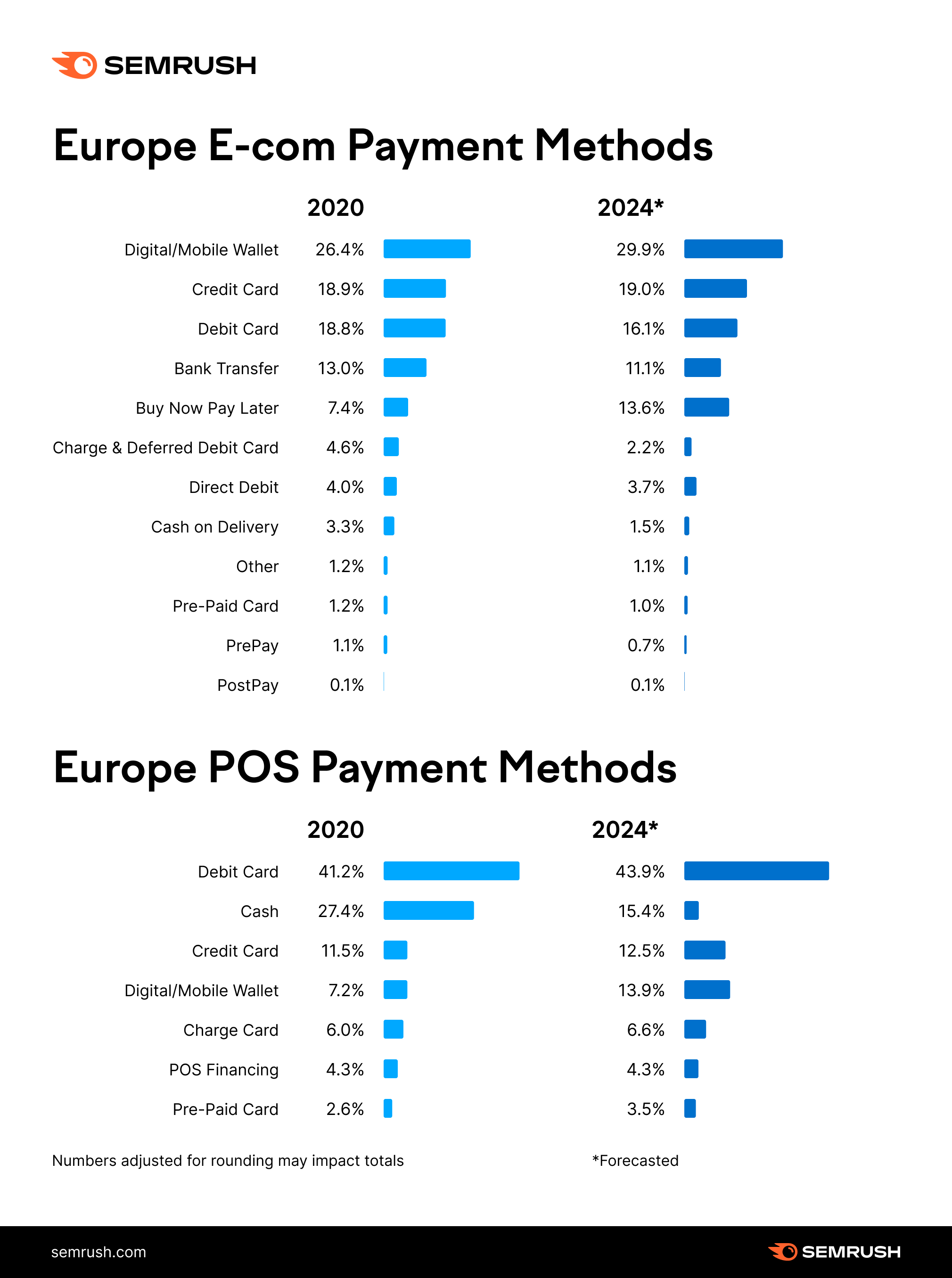
Latin America Ecommerce Payment Methods
In Latin America, cash is still king when it comes to CNP transactions. With 38% of transactions happening in cash, Latin America stands apart from most other regions, with debit cards being the preferred method. While this figure is expected to fall by 2024, it’s still an important thing to keep in mind when expanding into this market.
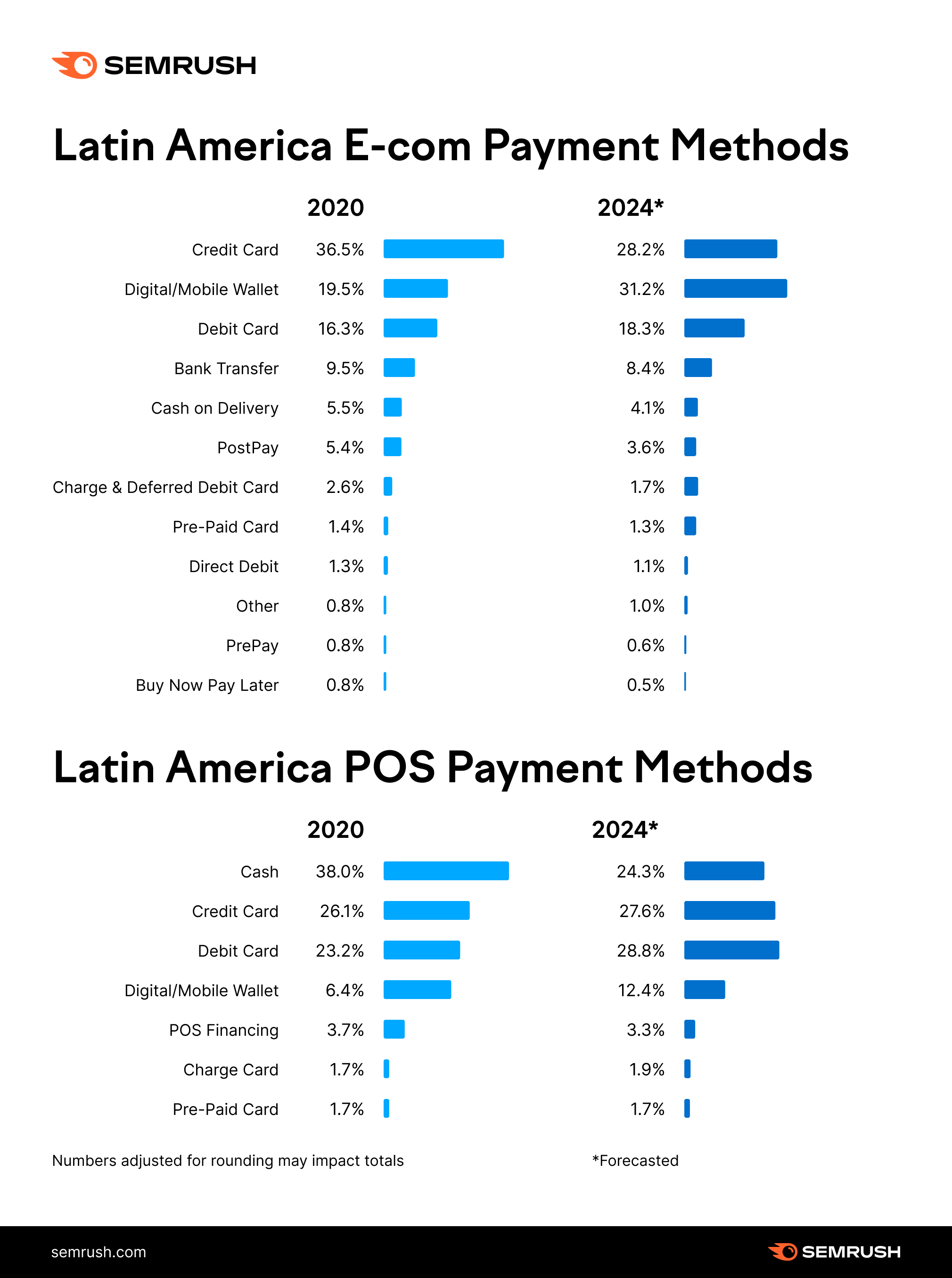
Asia-Pacific Ecommerce Payment Methods
Asia-Pacific markets are by far the most accustomed to digital and mobile wallets. Compared to the 44.5% of purchases made this way globally, Asia-Pacific markets stood at 60.2% and are projected to rise to 65.4% by 2024.
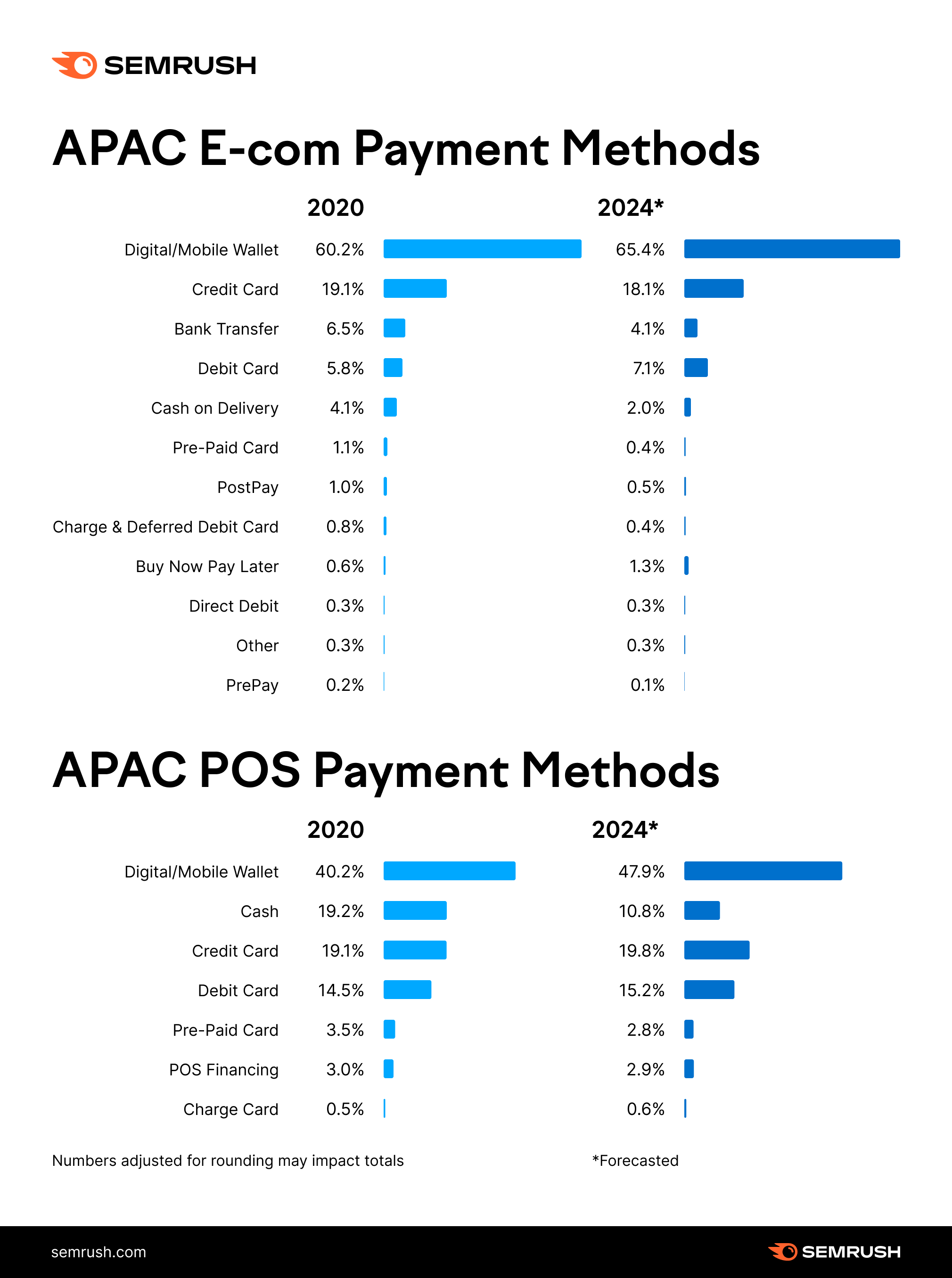
North America Ecommerce Payment Methods
And finally, North Americans still prefer their credit cards for payments, though this top payment method is projected to be taken over by digital and mobile wallets by 2024.
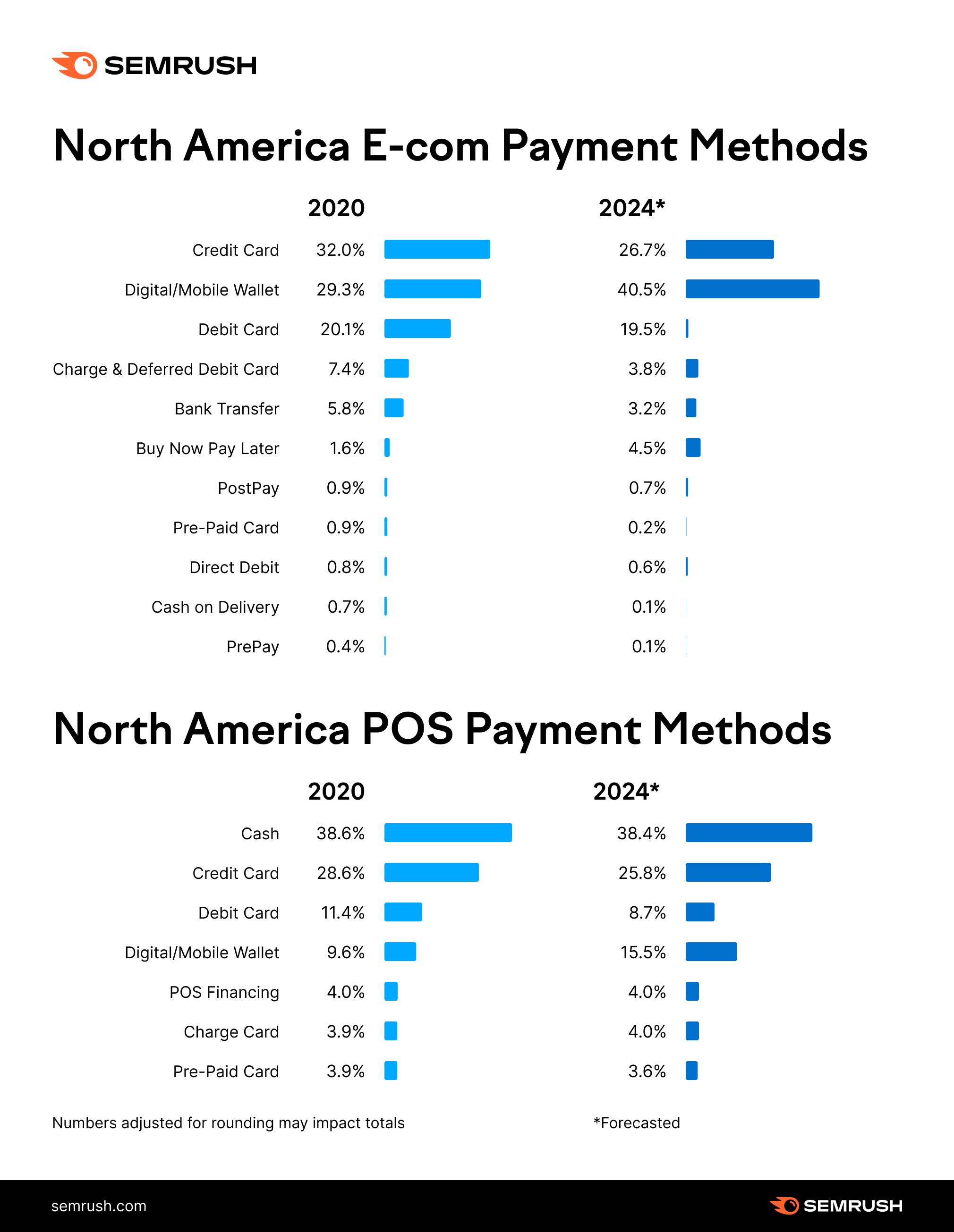
Attempting to break into a new market without the proper research on payment methods can leave your audience without their preferred options. And when it comes to spending money, people like familiarity, so you definitely want to match your offerings to their accustomed methods of payment.
8. Determine Your Go-to-Market Conversion Funnel and Shape Your Marketing Strategy
With knowledge about the market and audience, you can start thinking about your go-to-market conversion funnel and begin to build out your marketing strategy.
Before you start planning your marketing efforts, begin by thinking about your conversion funnel. Essentially, a conversion funnel is a model for thinking about customer journeys with your business. In other words, we want to think about how customers travel from their first contact with your business to becoming life-long loyal customers.
There are lots of different conversion funnel models, but a simple one depicts the customer journey in three stages:
- Top of Funnel (ToFu): The goal with the top of your conversion funnel is to generate interest, capture attention, and initiate the customer journey.
- Middle of Funnel (MoFu): The goal with the middle of your funnel is to nurture and guide leads toward becoming qualified customers.
- Bottom of Funnel (BoFu): The primary goal of the BoFu stage is to convert potential customers into actual customers.
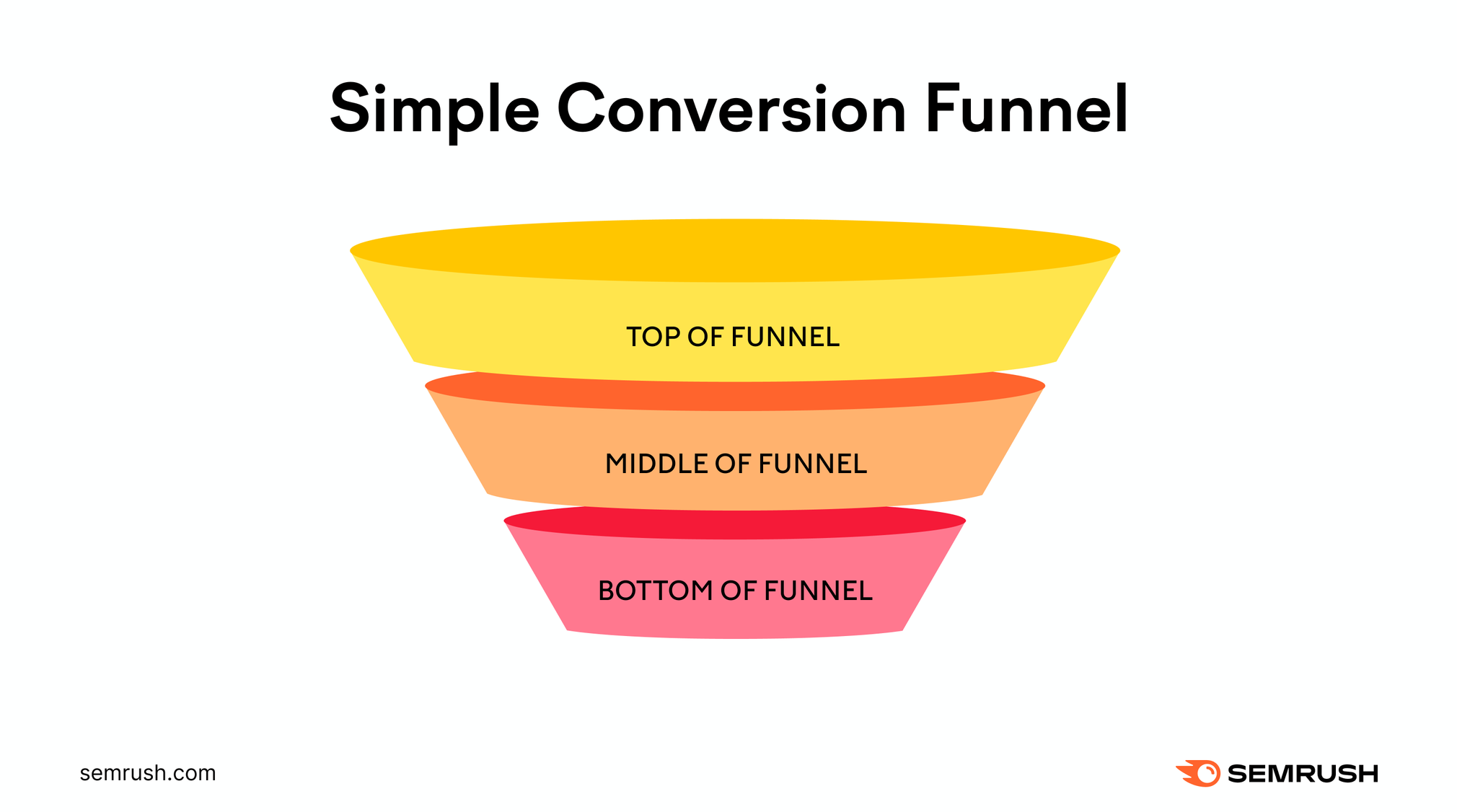
At each stage, you’ll need to think about how you’ll nurture your relationship with customers and move them along to the next stage of the funnel.
Having a structure like this will help you build out your marketing strategy. You can think about how different efforts in each area of the funnel will help move customers toward a purchase.
If your business is new and relatively unknown, you may need to focus on Top of Funnel strategies. If your business is well established and entering a new market or launching a new product, your focus might be the middle or bottom of your funnel.
Study Trends in Your Industry for Go-to-Market Marketing Strategies
Understanding marketing trends in your industry can help you understand what works, what marketing channels have the most competition, and which avenues may offer opportunities for you to gain an edge.
As a quick example, consider this graph from Semrush’s Market Explorer tool. It shows the Traffic Generation Strategies of top players in Brazil’s market for sunglasses.
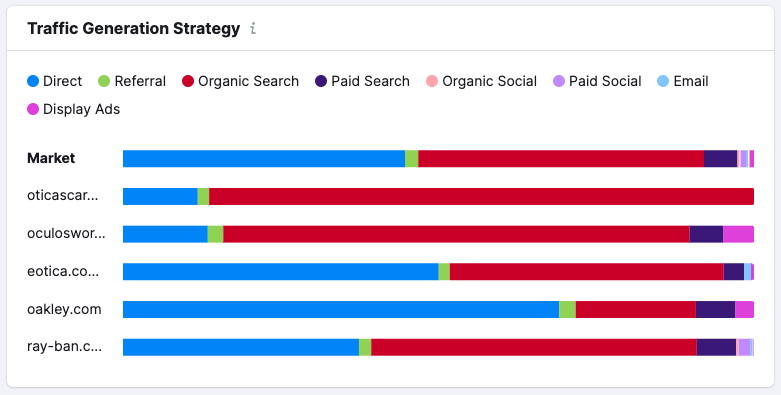
For this market, Direct and Organic Search are the top channels, followed by Paid Search. Looking at the strategies of individual players, it looks like oculosworld.com.br and oakley.com make use of Display Ads. On the other hand, ray-ban.com has a larger-than-average focus on paid social.
With this information, we can determine which channels might present the best opportunities for our strategy as we enter our new market. For example, an Organic Search strategy seems like a key feature of any strategy in this market, and we might also focus on social media campaigns because the competition is much lower than the Paid Search channel.
Ultimately, the more you know about how your market operates, the better your own decision-making process will be as you shape your own strategy.
Download Your Free Go-to-Market Strategy Template
Once you’ve worked through these 8 steps, you’re ready to pull everything together into a cohesive strategy.
We’ve developed this user-friendly template that outlines key components such as target audience analysis, product positioning, distribution channels, and promotional tactics.
This template is designed to help you strategize efficiently, ensuring a seamless and successful product launch. Click the link below to access the template and pave the way for a robust market entry.
Go-to-market strategy examples
Go-to-market strategies differ depending on your type of business and the unique nature of the market you’re seeking to enter. Learning from the successes of renowned companies can offer valuable insights into the various strategies that can be employed to achieve market success. Here are three go-to-market strategy examples.
Go-to-Market Strategy for Startups: Airbnb’s Success Story
Airbnb’s groundbreaking approach to the sharing economy revolutionized the hospitality industry and serves as a strong example of effective go-to-market strategies for startups.
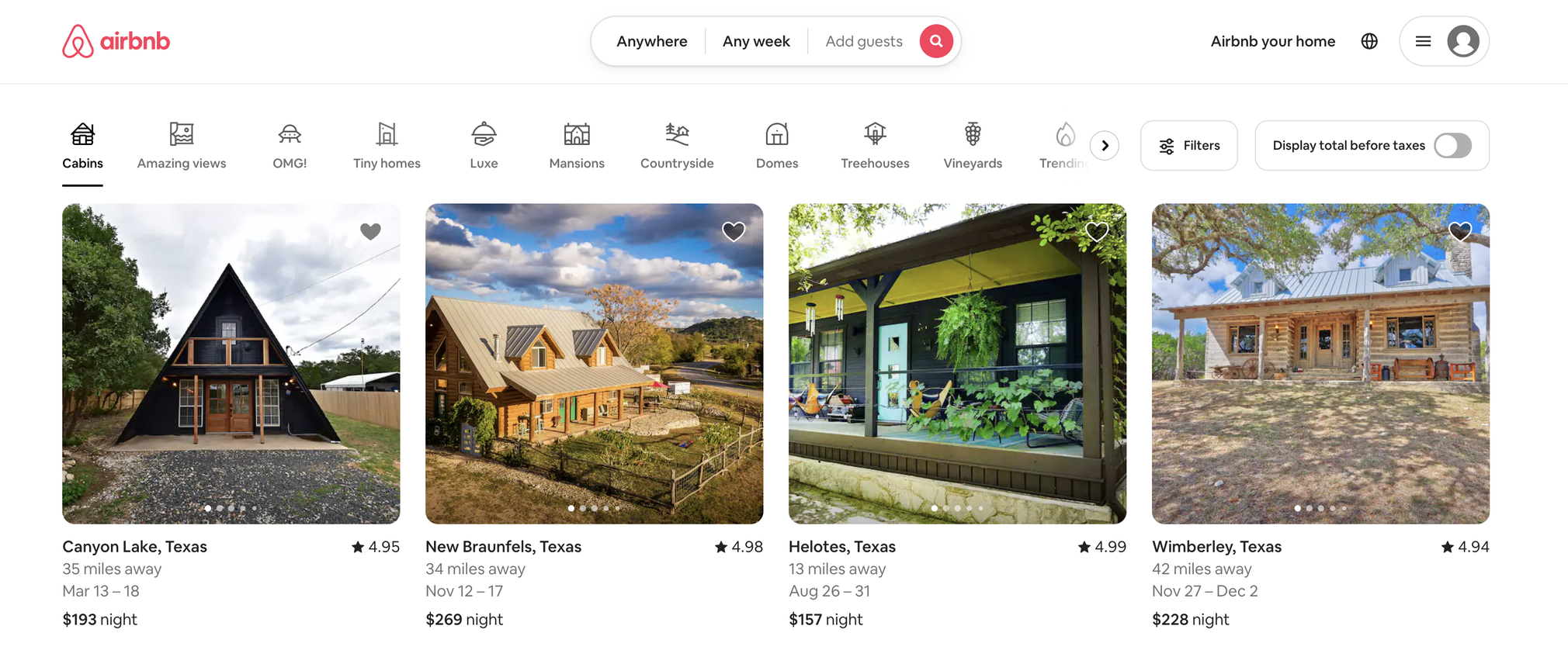
In examining Airbnb’s go-to-market strategy, we can see a few key features:
- Disruptive Innovation: Airbnb harnessed the power of the sharing economy, which was gaining momentum in 2008 when the business was just starting out. They offered a novel solution for affordable and personalized accommodations, challenging the traditional hospitality sector.
- User-Centric Platform Design: The company prioritized creating a user-friendly platform that simplified the booking process, fostering a seamless and enjoyable experience for both hosts and guests.
- Aggressive Digital Marketing: Airbnb’s aggressive digital marketing campaigns played a pivotal role in rapidly expanding its user base, leveraging various online channels to reach a global audience.
Key takeaways for startups:
- Identify Market Disruption Opportunities: Look for opportunities to disrupt traditional industries by offering innovative and consumer-centric solutions.
- Prioritize User Experience: Focus on creating intuitive and user-friendly products or services that prioritize customer convenience and satisfaction.
- Be Bold with Your Marketing: Allocate resources to develop a bold digital marketing strategy that effectively communicates your value proposition and inspires your target audience.
Emulating Airbnb’s strategic approach can empower startups to navigate the competitive landscape more effectively, fostering sustainable growth and establishing a strong foothold within their respective industries.
B2B Go-to-Market Strategies: Salesforce’s Expert Approach
Salesforce’s remarkable journey in the B2B sector offers a prime example of effective go-to-market strategies for businesses targeting enterprise clients.
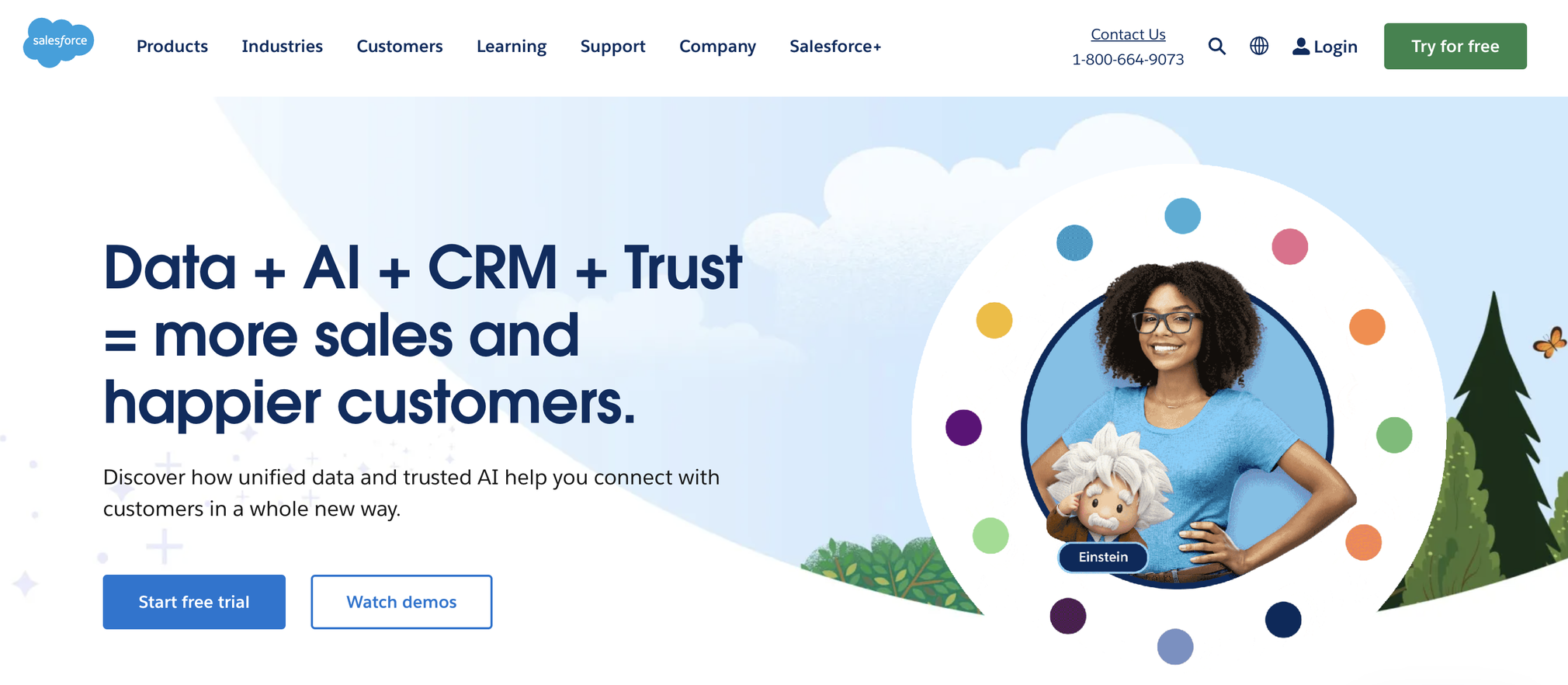
Here are a few key strategies employed by Salesforce:
- Build Trust and Credibility: Salesforce prioritized building strong relationships with key partners, establishing trust and credibility within the industry.
- Customizable Solutions: The company offers highly customizable and scalable solutions tailored to meet the specific and diverse needs of businesses, ensuring a personalized approach to each client.
- Robust Sales and Marketing Team: Salesforce employed a robust team of sales and marketing professionals who effectively demonstrated the value and benefits of their products to potential clients.
Key takeaways for B2B companies:
- Focus on Building Relationships: Invest in building robust and trust-based relationships with key stakeholders in the B2B sector to establish credibility and foster long-term partnerships.
- Offer Tailored Solutions: Develop customizable solutions that cater to the unique needs of businesses, showcasing a deep understanding of their pain points and requirements.
- Empower Your Sales Team: Equip your sales and marketing teams with the necessary resources and expertise to effectively communicate the value of your offerings and convert potential leads into long-term clients.
Adopting Salesforce’s strategic approach can provide valuable insights and guidance for B2B startups aiming to navigate the complex landscape of enterprise sales, fostering sustainable growth and establishing a strong market presence within the B2B segment.
SaaS Go-to-Market Strategies: Slack’s Seamless Strategy
Slack’s phenomenal success in the SaaS industry stands as a testament to the effectiveness of a well-crafted go-to-market strategy tailored to the unique demands of the modern digital workplace.
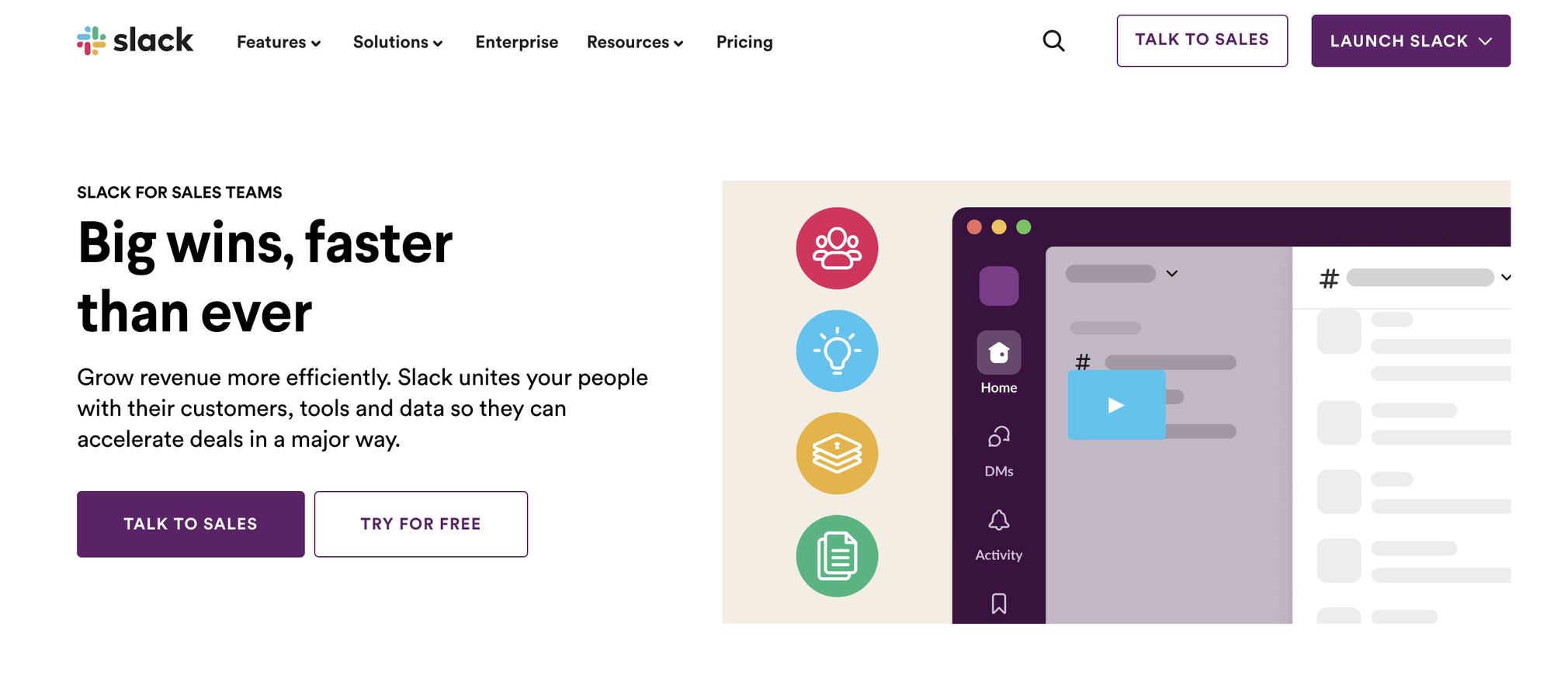
Slack’s go-to-market strategy included a few key features:
- Freemium Model Adoption: Slack leveraged a freemium model, offering a basic version of their communication platform for free, enticing users to experience its value before committing to a paid plan.
- Seamless Integration Capabilities: The platform integrates seamlessly with various third-party applications, enhancing user experience and streamlining workflow processes for businesses.
- Content Marketing and Community Engagement: Slack invested in comprehensive content marketing strategies and community engagement initiatives, building a strong brand presence and fostering an active user community.
Key Takeaways for SaaS companies:
- Embrace the Freemium Model: Consider adopting a freemium model that allows potential users to experience the value of your product before committing to a paid subscription, effectively showcasing its capabilities.
- Prioritize Integration and Compatibility: Focus on ensuring seamless integration with other popular applications to enhance user experience and provide a comprehensive solution that addresses diverse business needs.
- Invest in Community Building: Allocate resources to foster a vibrant and engaged user community, utilizing content marketing strategies to establish thought leadership and build brand credibility within the SaaS industry.
Drawing inspiration from Slack’s strategic approach can empower SaaS startups to navigate the competitive landscape more effectively, fostering sustainable growth and establishing a strong foothold within the rapidly evolving realm of digital business solutions.
Continue to Improve your Go-to-Market Strategy with Data-Driven Insights
Your go-to-market strategy will take time to create. It requires plenty of research and digging to avoid the types of errors that have hit big brands such as Uber and Coke. Likewise, you’ll need to continue to gather data and measure your success.
As you move forward with your plans to grow, make sure your decision is well-calibrated and data-driven. Assess the market you’re considering thoroughly, and don’t leave anything to chance. And use the elements mentioned in this article to build a go-to-market strategy that can’t fail.
